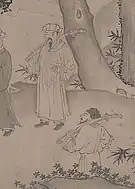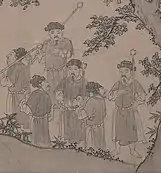Trần dynasty military tactics and organization
The House of Trần that ruled Đại Việt (Vietnam) from 1225 to 1400, employed various successful military tactics and strategies in the Mongol invasions of Vietnam. The included scorched earth and hit and run tactics designed to use advantage of terrain.
Organization
The Vietnamese Royal army had a military force of up to about 100,000 soldiers in 1281.[1][2]
Army
- Cấm quân (Royal army): about 20,000
- Lộ quân (Local army): about 80,000
| Military Title | Number of Men |
|---|---|
| Ngũ [3] | 16 |
| Đô [3] | 80 |
| Quân | 2,400 |
List of Cấm quân:
- Thiên Thuộc
- Thiên Cương
- Chương Thánh
- Củng Thần
- Thánh Dực
- Thần Sách
List of Lộ quân:
- Thiên Trường
- Long Hưng
- Quốc Oai
- Bắc Giang
- Hải Đông
- Trường Yên
- Kiến Xương
- Hồng
- Khoái
- Thanh Hóa
- Hoàng Giang
- Diễn Châu
Cấm quân was the force guarding the city of Thăng Long, capital of Đại Việt.[3]
Lộ quân was the force protecting the "Lộ" (administrative divisions in the Trần dynasty period).[3][4] Every "Lộ" had one Quân and 20 support units called "Phong đoàn",[5] about 120 soldiers.
Navy
During the interwar periods, the Royal Vietnamese Navy consisted of:
- Đông Hải Quân (Eastern navy)[6] consisted of 2,400 sailors, that fought on rivers, the sea and beaches.
- Bình Hải Quân[6] consisted of a "Quân", which is supported by 900 sailors on 30 sailboats, who fought at sea, on islands and at the mouths of rivers. Its headquarter is located on the island of Vân Đồn.[3][7]
The total number of the Trần naval vessels is uncertain. However, figures obtained during the Battle of Vạn Kiếp (began on 11 February 1285) hint at a sizeable fleet, as the Vietnamese navy maintained over 1,000 medium-sized sailboats of the type used on rivers.[8]
Other forces
- Sương quân was the army of the rich families or of the sovereign personally but not of the Trần royal dynasty.
- Vương hầu quân was an army recruited by royal nobles, who trained and equipped it themselves. According to royal law, there could have been about 1,000 of them. Their forces were rather important in war when the Mongols invaded Đại Việt.[9]
Military policy
An important military policy of the Trần dynasty was "Ngụ binh ư nông" (Hán văn: 寓兵於農). When the nation was at peace, the royal house did not need more soldiers. Part of the military force was maintained permanently; otherwise, almost every man of military age was able to work his farm. Changes required to meet military needs were dealt with by occasional or part-time service. When the nation was under threat of invasion, however, the emperor was able to call on all of the available manpower.[10][11]
In 1284, the Trần dynasty forces consisted of 200,000 soldiers in anticipation of a Mongol invasion.[3]
Strategy
The Trần continued and passed on proven Vietnamese military traditions, such as asymmetry, elusive main face-to-face combat and enemy atrition. The actual combatants received full support of the entire national population. Resilience and sheer perseverance eventually triumphed over their opponents' short-lived achievements, when usually Vietnam lost most of the battles but won the war. [12]
People's war
When Đại Việt was under attack by the Mongols, all people joined in the war: the threat of invasion called forth the spirit of solidarity and psychological self-defense as expressed in the Vietnamese slogan: "Cử quốc nghênh địch" ("The whole country face to face with the enemy").[13][14][15]
At the Diên Hồng conference,[14] when the Đại Việt emperor asked: "Should we surrender or fight?", the unanimous response of all members of Trần royalty, military commanders and senior counsellors was: "Fight!".[16]
Soldiers of the Trần dynasty tattooed two words by Hán văn on their hands 殺韃, modern Vietnamese is: "Sát Thát" (meaning: "Kill Mongolians").[8]
Scorched earth
Thăng Long, capital of Đại Việt, collapsed every time the Mongolians came, but they did not know that the Vietnamese were psychologically prepared to abandon Thăng Long at short notice, as they realised early on that they could not protect it but adopted the scorched earth strategy, carrying away what they could, and destroying everything else, so that the Mongolian troops could not use anything. This strategy was called in Vietnamese: "Vườn không nhà trống" ("Both garden and house are empty").[17]
Longdays war
The favorite tactic of the Vietnamese was to prolong the time of the war, causing the Mongolian enemy to become bogged down in the rainy season, when they began to be infected with tropical diseases, and to deplete their war resources, as in the Vietnamese expression: "Lấy sức nhàn thắng sức mỏi"[13] ("Our troops in good health smite the tired enemy troops").
Tactics
Advantage of terrain, hit and run, and ambushes
Vietnamese military did not stop the Mongols from the beginning of the war, but let Mongol army moving deep into Đại Việt territory.[15] They make use of the understanding of their territory, the advantages of terrain. Build secret bases to hide and ambush points when they fighting. Take this advantage, Vietnamese attack and defense very flexible. Not only did the Mongols used hit and run tactic, Vietnamese were even more proficient this tactic as an art. When they could not win, they retreat quickly.
In the Battle of Bạch Đằng, Vietnamese used tactic hit and run, allure Mongol battleship moving to ambush place on Bạch Đằng river, and defeated them.
Attack enemy logistics
Vietnamese continuing to attack the enemy's military logistics. They're understand with a huge numbers of army which 500,000 man (soldiers and supportmans) Mongol wanna huge logistics. They're repeatedly attacked Mongol's supply lines. When they can not succeed, they choose the other times to attack the Mongol reserve treasures. With that things, when the logistics decline, Mongolian with large troops numbers will be exhausted.
In third time Mongol invade Đại Việt, they used 70 transport ships, movement 170.000 koku food. Vietnamese guess that's thing at soon time, that Mongol will find way to war without logistics problem of them. Vietnamese army and navy waiting Mongol come, and a navy battle was happened, almost transport ships sunk, fastly Mongol ready a plan to run away out of Đại Việt. They knows they can not fights without food.[17]
Counter offensive
The Vietnamese forces frequently launched counter-offensives against the Mongols.[13][17]
List of wars and battles
Wars with Mongol
- Mongol-Vietnamese War
- Naval battle:[3]
- Battle of Vân Đồn (11 February 1285)
- Battle of Bình Than (14 February 1285)
- Battle of Bạch Đằng (1288)
- Naval battle:[3]
War with Champa
- Cham-Vietnamese War (1367-1396)
Civil war
- Coup d'état of Hồ Quý Ly
See also
- Hịch tướng sĩ
- Binh thư yếu lược
- Vạn Kiếp tông bí truyền thư
Notes
- Phan Huy Chú, p 5.
- Trương Hữu Quýnh, 2008, p 182.
- "Tìm hiểu về tổ chức quân đội nhà Trần trong chiến tranh chống quân Nguyên xâm lược". Biên phòng Việt Nam (in Vietnamese). Archived from the original on 2019-06-13. Retrieved 19 September 2018.
- Trương Hữu Quýnh, 2008, pp. 177–178.
- "Quá trình hình thành và phát triển các tổ chức quân sự ở Việt Nam". vnmilitaryhistory.net (in Vietnamese). Archived from the original on 2019-06-13. Retrieved 19 September 2018.
- "Sử dụng thuyền chiến trong lịch sử dựng nước". Hải quân Việt Nam (in Vietnamese). Archived from the original on 2019-06-13. Retrieved 25 September 2018.
- "Trần Khánh Dư - Vị tướng thủy quân tài ba chống giặc ngoại xâm". Báo Mới (in Vietnamese). Archived from the original on 2019-06-13. Retrieved 25 September 2018.
- "Tư tưởng "dĩ đoản, chế trường" - Đỉnh cao nghệ thuật quân sự Việt Nam" (in Vietnamese). Nam Định Province Library. Archived from the original on 2019-10-28. Retrieved 23 September 2018.
- Trương Hữu Quýnh, 2008, p 181.
- "Quốc sách 'gửi binh lính vào trong dân' thời phong kiến". vnexpress.net (in Vietnamese). Archived from the original on 2019-11-21. Retrieved 19 September 2018.
- "Chính sách "NGỤ BINH Ư NÔNG" và vấn đề kết hợp kinh tế với quốc phòng". Văn hiến Việt Nam (in Vietnamese). Archived from the original on 2019-06-13. Retrieved 19 September 2018.
- Paul D. Buell. "Mongols in Vietnam: End of one Era, Beginning of Another". Charitè Medical University, Berlin. Retrieved November 29, 2019.
- "Nghệ thuật quân sự trong cuộc kháng chiến chống quân Nguyên Mông của nhà Trần" (in Vietnamese). Archived from the original on 2019-06-13. Retrieved 23 September 2018.
- "Tướng Giáp nói về tài thao lược của Hưng Đạo Vương" (in Vietnamese). vi:Đài Truyền hình Kỹ thuật số VTC. Archived from the original on 2019-11-21. Retrieved 21 November 2019.
- "Bài 7 NGHỆ THUẬT QUÂN SỰ VIỆT NAM" (in Vietnamese). Archived from the original on 2019-06-13. Retrieved 23 September 2018.
- Đại Việt sử ký toàn thư, Book V
- Tạp chí Quốc phòng toàn dân. ""Thủy chiến" - nét nghệ thuật đặc sắc trong Cuộc kháng chiến chống quân xâm lược Nguyên - Mông" (in Vietnamese). Archived from the original on 2019-06-13. Retrieved 23 September 2018.
References
Vietnamese language:
- Phan Huy Chú, Lịch triều hiến chương loại chí, Book IV, Binh chế chí.
- Trương Hữu Quýnh, Đinh Xuân Lâm, Lê Mậu Hãn chủ biên (2008), Đại cương lịch sử Việt Nam, NXB Giáo dục.
.jpg.webp)

